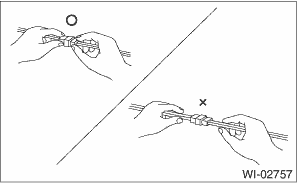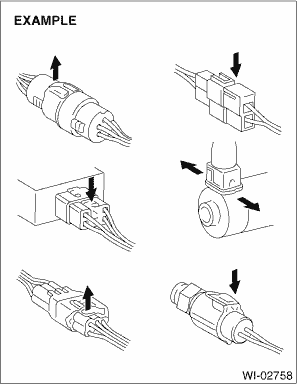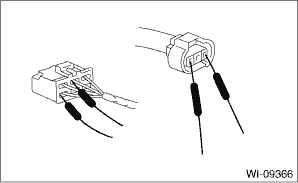Subaru Crosstrek Service Manual: Precautions in trouble diagnosis and repair of electric parts
WIRING SYSTEM > Working Precautions
PRECAUTIONS IN TROUBLE DIAGNOSIS AND REPAIR OF ELECTRIC PARTS
1. The battery cable must be disconnected from the battery’s (−) terminal, and the ignition switch must be set to the OFF position, unless otherwise required by the diagnostics.
2. Securely fasten the wiring harness with clamps and clips so that the harness does not interfere with the body end parts, edges, bolts or screws.
3. When installing parts, be careful not to catch them on the wiring harness.
4. When disconnecting a connector, do not pull the wires, but pull while holding the connector body.

5. Some connectors are provided with a lock. One type of such a connector is disconnected by pushing the lock, and the other, by moving the lock up. In either type the lock shape must be identified before attempting to disconnect the connector.
To connect, insert the connector until it snaps and confirm that it is connected securely.

6. When checking continuity between connector terminals, or measuring voltage across the terminal and ground, always touch tester probe(s) to terminals from the wiring connection side. If the probe is too thick to gain access to the terminal, use “mini” test leads.
To check water-proof connectors (which are not measurable from the wiring side), touch test probes on the terminal side and be careful not to bend or damage the terminals.

7. When measuring the voltage or resistance of individual sensor or all electrical control modules, use a tapered pin with a diameter of 0.6 mm (0.024 in) or less and touch it to the tip of terminal. Never insert the tapered pin into the terminal at this time. Doing so may cause internal deformation and a malfunction can occur.
8. Sensors, relays, electrical unit, etc., are sensitive to strong impacts.
Handle them with care so that they are not dropped or mishandled.
 Precautions when working with the parts mounted on the vehicle
Precautions when working with the parts mounted on the vehicle
WIRING SYSTEM > Working PrecautionsPRECAUTIONS WHEN WORKING WITH THE PARTS MOUNTED ON THE VEHICLE1. When working under a vehicle which is jacked-up, always be sure to use rigid rack.2. The parking ...
 Air conditioning system Wiring diagram
Air conditioning system Wiring diagram
WIRING SYSTEM > Air Conditioning SystemWIRING DIAGRAM1. MANUAL A/C MODEL2. AUTO A/C MODEL ...
Other materials:
Operation
TELEMATICS SYSTEM (DIAGNOSTICS) > System Operation Check ModeOPERATION1. On «Start» display, select «Diagnosis».2. On «Vehicle selection» display, input the target vehicle information and select «Confirmed».3. On «Main Menu» display, select «Each System».4. On «Select System» displa ...
Brake fluid
Checking the fluid level
WARNING
Never let brake fluid contact your
eyes because brake fluid can be
harmful to your eyes. If brake
fluid gets in your eyes, immediately
flush them thoroughly with
clean water. For safety, when
performing this work, wearing
eye protection is advisabl ...
Dtc p0967 pressure control solenoid "b" control circuit high
CONTINUOUSLY VARIABLE TRANSMISSION (DIAGNOSTICS) > Diagnostic Procedure with Diagnostic Trouble Code (DTC)DTC P0967 PRESSURE CONTROL SOLENOID "B" CONTROL CIRCUIT HIGHDTC detecting condition:Immediately at fault recognitionTrouble symptom:Engine speed increases abruptly, and can not star ...
